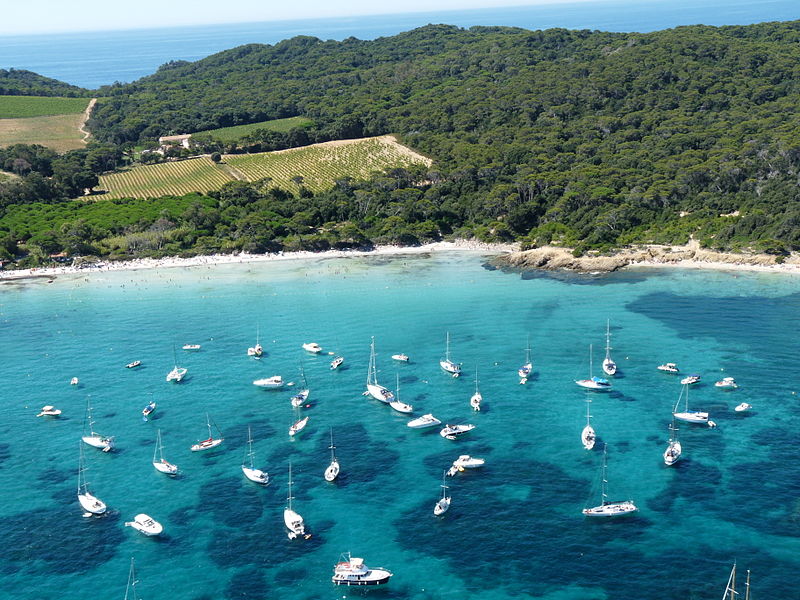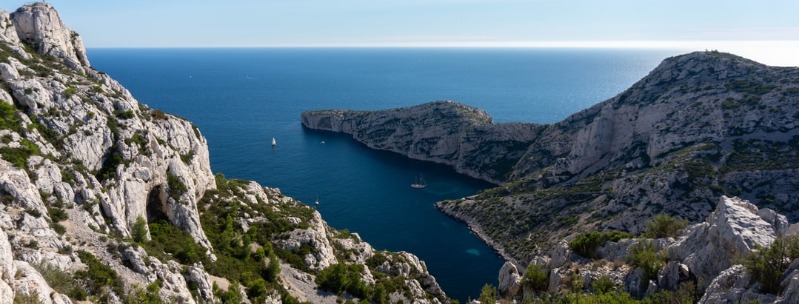Most Beautiful Beaches in Hyères, France
The coastline that surrounds Hyeres has turquoise blue waters and golden sands. The dense woodland that encircles this stretch of coast offers an interesting visual contrast to these South France beaches.
A haven from tempests in ancient times, then the peaceful home of monks and farmers, the Iles d’Hyeres became, from the Middle Ages onwards, the target of piracy and coastal attacks by an endless succession of assorted aggressors.
Golden Islands – South France Beaches
Just off the coast of Hyeres, less than half an hour by boat, are three stunning islands with stunning beaches that have yet to be truly “discovered” by the British – though they are popular with the French and are busy at peak season. The Ile de Hyeres, also known as the Golden Islands, offers some excellent sunbathing opportunities.
The three main islands, Porquerolles, Port-Cros, and Levant, are covered in half-destroyed, rebuilt, or abandoned forts, dating from the sixteenth century, when Francois I started a trend of under-funded fort building, up to the twentieth century, when the German gun positions on Port-Cros and Levant were put out of action by the Americans.
Porquerolles and Levant are not yet free of garrisons, thanks to the knack of the French armed forces for securing prime beauty sites for their bases. But their presence has prevented the otherwise inevitable Cote build-up and, in the non-military areas, the islands’ very fragile environment is protected by the Parc National de Port-Cros and the Conservatoire Botanique de Porquerolles. Best Iles d’Hyeres beaches:
Porquerolles Island Beaches – South France
The most easily accessible of the Iles d’Hyeres is Porquerolles, whose permanent village, also called Porquerolles, has a few hotels and restaurants, plenty of cafes, a market, and interminable games of boules. It dates from a nineteenth-century military settlement, and the village still focuses around the central place d’Armes, the erstwhile military exercise ground. In summer its population explodes to over 10,000, but there is some activity all year round. This is the only cultivated island of the three and has its own wine, appellation Cotes des Iles.

Porquerolles is big enough to find yourself alone amid its stunning landscapes.
The lighthouse due south of the village and the Calanques to its east make good destinations for an hour’s walk, though don’t even think of swimming on this side of the island. The southern shoreline is all cliffs, with scary paths meandering close to the edge through heather and exuberant maquis scrub.
The longest beach is the Plage de Notre Dame, 3km northeast of the village just before the terrain militaire on the northern tip.
The nearest beach to the village is the plage d’Argent, 1km away (continue west from the port past the Arche de Noe and take the first, well-signed right). This 500-meter strip of white sand fringes a curving bay backed by pine forests and has a pleasant restaurant, La Plage d’Argent.
Ile De Port-Cros
A mountainous national park and bird sanctuary are known for its rare flora, aquatic fauna, and hiking trails. Visit the beaches of Palud and Plage du Sud.
The dense vegetation and mini-mountains of Port-Cros make its exploration much tougher than Porquerolles, even though it is less than half the size.
Aside from ruined forts and the handful of buildings around the port, the only intervention on the island’s wildlife is the classification labels on some of the plants and the extensive network of paths; you’re not supposed to stray from these signposted routes and it would be very difficult to do so given the thickness of the undergrowth.

The entire island is a protected zone and has the richest fauna and flora of all the islands. Kestrels, eagles, and sparrowhawks nest here; there are shrubs that flower and bear fruit at the same time, and more common species like broom, lavender, rosemary, and heather flourish in abundance.
It takes a couple of hours to walk from the port to the nearest beach, plage de la Palu; a similar time to cross the island via the Vallon de la Solitude or Vallon de la Fausse Monnaie. You can also follow a ten-kilometer circuit of the island.
Ile du Levant
The l’île du Levant – ninety percent military reserve – is almost always humid and sunny.
Cultivated plant life goes wild, with the result that giant geraniums and nasturtiums climb three-meter hedges, overhung by gigantic eucalyptus trees and yucca plants.

The tiny bit of the island spared by the military is a nudist colony, set up in the village of Heliopolis in the early 1930s. About sixty people live here all the year round, joined by thousands who come just for the summer, and by tens of thousands of day-trippers.
Visitors who come to the colony for just a couple of hours tend to be treated as voyeurs. If you stay, even for one night, you’ll generally receive a much friendlier reception. The most reasonable hotels on the island are La Source and the more chi-chi La Brise Marine. There are three campsites: Le Colombero, La Joie de Vivre, and La Pineda.
Hyères Beaches
Hyeres is the oldest resort on the Cote, listing Queen Victoria and Tolstoy among its early admirers, but the lack of a central seafront meant the town lost out when the foreign rich switched from winter convalescents to quayside strollers. It is, nevertheless, a very popular resort, but has the rare distinction, for this part of the world, of not being totally dependent on the summer influx.
The town exports cut flowers and exotic plants, the most important being the date palm, which graces every street in the city – and numerous desert palaces in Arabia. The orchards, nursery gardens, and vineyards taking up land which elsewhere would have become a rash of holiday shelving units are crucial to its economy.
Hyeres’s coastal suburbs have plenty of beaches for you to choose from, but can be subject to mosquito plagues. L’Almanarre, about 5km south of town, hosts French sailing championships at the end of April and has a narrow crescent of sand from which you can swim. La Capte is rather built-up, but offers warmer, shallow water and a long sandy beach. Alternatively, take the route du Sel to the Presqu’Ile de Giens for a glimpse of the saltworks and the flamingos on the adjoining lake. Besides the peculiarity of its attachment to the mainland (last broken by storms in 1811), Giens is a fairly nondescript and overpopulated resort. There are, however, some fine cliffs facing the sea, and in rough weather, you can understand why so many wrecks have been discovered here. La Tour Fondue, a Richelieu construction on the eastern side of Giens, overlooks the small port that serves the Iles d’Hyeres.
Traffic fumes and the proximity to the airport make the beaches between Hyeres-Plage and Le Ceinturon/Ayguade rather undesirable despite the pines and ubiquitous palms. Best to head further up the coast to the little fishing port of Les Salins d’Hyeres. East of Les Salins, where the coastal road finally turns inland, you can follow a path between abandoned salt flats and the sea to a natural beach.
